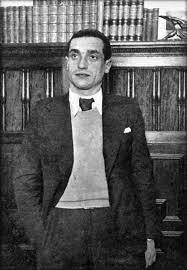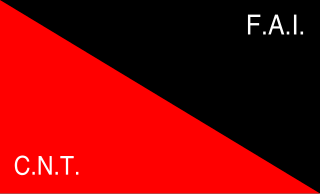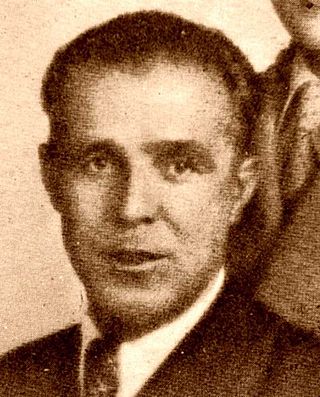
The Spanish Revolution was a workers' social revolution that began at the outbreak of the Spanish Civil War in 1936 and for two to three years resulted in the widespread implementation of anarchist and, more broadly, libertarian socialist organizational principles throughout various portions of the country, primarily Catalonia, Aragon, Andalusia, and parts of the Valencian Community. Much of the economy of Spain was put under worker control; in anarchist strongholds like Catalonia, the figure was as high as 75%. Factories were run through worker committees, and agrarian areas became collectivized and run as libertarian socialist communes. Many small businesses, such as hotels, barber shops, and restaurants, were also collectivized and managed by their workers.

José Buenaventura Durruti Dumange was a Spanish insurrectionary, anarcho-syndicalist militant involved with the CNT and the FAI in the periods before and during the Spanish Civil War of 1936–1939. Durruti played an influential role during the Spanish Revolution of 1936 and is remembered as a hero in and by the anarchist movement.
The Durruti Column, with about 6,000 people, was the largest anarchist column formed during the Spanish Civil War. During the first months of the war, it became the most recognized and popular military organisation fighting against Franco, and it is a symbol of the Spanish anarchist movement and its struggle to create an egalitarian society with elements of individualism and collectivism. The column included people from all over the world. Philosopher Simone Weil fought alongside Buenaventura Durruti in the Durruti Column, and her memories and experiences from the war can be found in her book, Écrits historiques et politiques. The Durruti Column was militarised in 1937, becoming part of the 26th Division on 28 April.

Camillo Berneri was an Italian professor of philosophy, anarchist militant, propagandist and theorist. He was assassinated during the Spanish Civil War, presumably on the orders from Stalin's USSR.
The Battle of Monte Pelado was an engagement of the Spanish Civil War fought on 28 August 1936. It was notable as the first major engagement of the Italian Republican volunteers of the Matteotti Battalion.
The Friends of Durruti Group was a Spanish anarchist group commonly known for its participation in the May Days. Named after Buenaventura Durruti, it was founded on 15 March 1937 by Jaume Balius i Mir and Félix Martínez, who had become disillusioned with the policies of the CNT-FAI's leadership. During the May Days in Barcelona, they actively agitated among the anti-government forces, advocating for the formation of a "revolutionary junta", in close collaboration with Spanish Trotskyists. Following the suppression of the uprising, the group began publishing the newspaper El Amigo del Pueblo, in which they denounced the CNT-FAI for "collaborationism", resulting in their expulsion from the organisation. Their 1938 pamphlet Towards a Fresh revolution, which reaffirmed their proposals for a revolutionary junta, became an influential text within the anarchist current of platformism. But the group ultimately failed to make a broader impact within the Spanish movement and collapsed by the end of the war.

Joaquín Ascaso Budría was an Aragonese anarcho-syndicalist and President of the Regional Defence Council of Aragon between 1936 and 1937.

The Regional Defence Council of Aragon, was an administrative entity created by the Confederación Nacional del Trabajo (CNT) in the context of the Spanish Revolution, during the Spanish Civil War. Until its dissolution, the CRDA controlled and administered the eastern half of Aragon. The price of goods was centrally controlled to mitigate inflation.

Pepita Laguarda Batet (1919–1936), was a Catalan anarchist militiawoman who fought on the Aragon front during the Spanish Civil War. She was incorporated into the libertarian ranks without having yet reached adulthood and died in Uesca at the age of seventeen. She was the youngest soldier to die in combat during the war.
The People's Army of Catalonia was an army created by the Generalitat of Catalonia on 6 December 1936, during the Spanish Civil War. Its existence was more theoretical than real, because the original structure of the popular militias continued to exist despite the efforts of the Generalitat. After the May Days it was dissolved and its structure assumed by the Spanish Republican Army, which definitively militarized the militias of Catalonia and Aragon.

The confederal militias were a movement of people's militia during the Spanish Civil War organized by the Spanish anarchist movement: the National Confederation of Labor (CNT) and the Iberian Anarchist Federation (FAI). The CNT militias replaced clandestine defense committees instituted earlier. As the war progressed, the militias were progressively dissolved and assimilated into the Spanish Republican Army, in spite of many militiamen refusing the militarization.
The Harriers Column of the FAI, or Los Aguiluchos, was the last of the great Catalan anarcho-syndicalist columns. Later, more militias left Catalonia for the front, but they would no longer do so in the form of a column but rather as reinforcement units of the existing columns. This column was supposed to form a large unit - of around 10,000 combatants - but it ended up reinforcing the Ascaso Column as an autonomous column - with about 1,500 militiamen with 200 militiawomen. Organized in the Bakunin barracks in Barcelona, it was sent to the Huesca front on 28 August, with Juan García Oliver and Miguel García Vivancos leading the column.

Ricardo Sanz García (1898–1986) was a Valencian anarchist militant. A member of Buenaventura Durruti's insurgent group Los Solidarios, Sanz participated in the anarchist armed struggle against the Spanish monarchy and the dictatorship of Primo de Rivera. Following the proclamation of the Second Spanish Republic, he became a leader of the Confederación Nacional del Trabajo (CNT) and Federación Anarquista Ibérica (FAI) in Catalonia. During the Spanish Civil War, Sanz oversaw the training of the confederal militias and went on to lead the Durruti Column following the death of its namesake. In command of the Aragon front, he attempted multiple unsuccessful offensives against Zaragoza, but was either hampered by severe weather or held back by the Ministry of Defence. After the militarisation of the Column, he continued to command it as the reorganised 26th Division, but came into conflict with Communist-aligned commanders of the Spanish Republican Army. After the Nationalist victory in the Aragon Offensive, Sanz fled to France, where he remained for the rest of his life.

Gregorio Jover Cortés was an Aragonese anarcho-syndicalist and a member of the CNT during the first third of the 20th century. During the Spanish Civil War he was commander of the Ascaso Column and later the militarized 28th Division, which fought on the Aragon front.
The 25th Division was one of the divisions of the Spanish Republican Army that were organized during the Spanish Civil War on the basis of the Mixed Brigades. It participated in the battles of Huesca, Belchite, Teruel and Levante.
The 28th Division was one of the divisions of the Spanish Republican Army that were organized during the Spanish Civil War on the basis of the Mixed Brigades. It was deployed on the Aragon and Segre fronts.
The 125th Mixed Brigade was a unit of the Spanish Republican Army, integrated into the 28th Division, that participated in the Spanish Civil War.
The 127th Mixed Brigade was a unit of the Spanish Republican Army, belonging to the 28th Division, created during the Spanish Civil War. It operated on the Aragón and Extremadura fronts.
Enric Pérez i Farràs was a Catalan military commander.
The 29th Division was a military formation belonging to the Spanish Republican Army that fought during the Spanish Civil War. Originally created in 1937 from the militarization of the POUM militia column, it was dissolved and recreated again in early 1938, operating on the Extremadura front.









